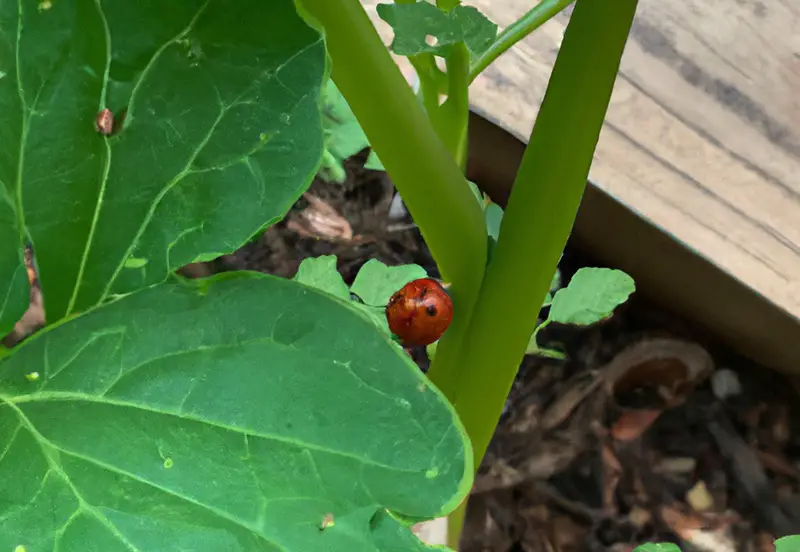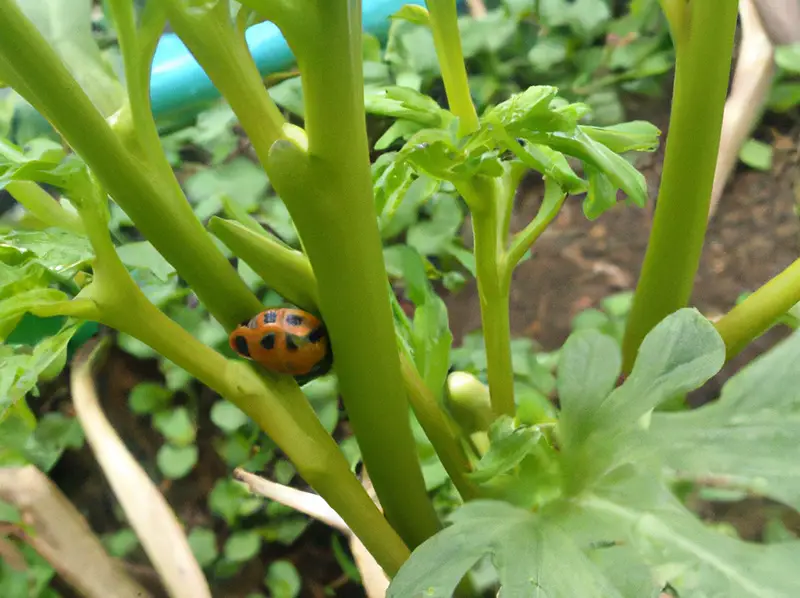Welcome fellow gardeners! If you’re looking to attract ladybugs to your vegetable garden, then you are coming to the right place. In the following paragraphs, I’ll share with you some simple and organic ways that will help bring these beneficial bugs into your space and make them feel right at home.
A healthy organic garden would not be complete without ladybugs. They eat pests like aphids, mites, and scales that threaten our valuable crops. By encouraging these beneficial insects to visit your vegetable garden, you will enjoy the satisfaction of having made a positive contribution to the well-being of a species that relies on your garden for survival.
So if you’re ready to learn how to create a perfect habitat for these little critters in your own backyard, read on! With my expertise in organic gardening combined with some creativity, I guarantee that soon enough your veggie patch will be teeming with ladybugs all around!
1. Attract Ladybugs Into Your Garden With Pollen-Rich Blooms
Do you ever wonder why many gardens are so replete with ladybugs? One obvious reason is that they are attracted to flowers with much pollen. When flowers are abundant with sweet nectar, pollinators have a bountiful food source and can flourish. That’s why it’s a good idea to attract ladybirds to your yard by planting flowers with lots of pollen. There are several flowering plant varieties, from daisies and coreopsis to cosmos and sunflowers, that will bring these helpful bugs right into your garden.
These blossoms not only attract ladybugs but also provide a safe haven for the insects’ larvae. So if you want to see more of these sociable creatures in your outside area, think about bringing in some vibrant flowers. In addition to improving your landscape’s aesthetics, this strategy may also help you reduce pest populations.
2. Provide A Water Source
Creating a water source for your garden is essential in attracting ladybugs. Having an accessible, safe place to drink and bathe will make them feel welcome in your yard. Here are some tips to help create the perfect oasis:
Water sources:
- Choose a shallow container that has no edges more than two inches deep so that younger bugs can easily access it.
- Make sure the water is not treated with any chemicals like chlorine or pesticides as these can be harmful to insects.
- Place rocks around the edge of the container for easy access and provide somewhere for them to land safely when drinking or bathing.
Maintenance:
- Change out the water regularly and keep it clean by scrubbing down any algae growths or leaves from time to time.
- Ensure there’s enough dirt nearby so they have somewhere comfortable to sit while they dry off after taking a dip!
3. Make A Ladybug Feeder
Creating a ladybug feeder can be an effective way to attract these helpful insects to your vegetable garden. Ladybugs love sweet liquids, so you should make sure the feeder has sugar water inside. Just combine a teaspoon of white sugar with two cups of warm water in a wide dish. Maintain a regular check on the feeding station to see if the ladybugs are using it as a gathering spot.
There are several do-it-yourself feeder solutions accessible on the internet if you don’t have access to store-bought feeders. A foam ball painted with bright colors and pierced with little holes throughout its surface could be used as a resting spot and water source for the bugs. You can also fill plastic containers with cotton balls soaked in sugary water and hang them near your plants.
Once you’ve created your makeshift ladybug feeder, position it away from direct sunlight and windy locations — these conditions might deter the bugs from visiting. Keep an eye on the area surrounding your larder; if the weather is nice and no other animals are present, then you may start seeing some visitors!
4. Grow Plants And Flowers Ladybugs Like
Ah, the old-fashioned way of attracting ladybugs to your vegetable garden – growing plants and flowers they love. In this day and age of chemical warfare on our bugs (and us!), it’s a welcome reminder that planting can still be our first line of defense against pests.
As a gardening expert, I always recommend starting with whatever is native to your area if possible; not only are these varieties more resistant to disease, but they also provide food for local wildlife like birds and bees. Planting nectar-rich flowers such as daisies, marigolds, dill, fennel, and yarrow will bring in plenty of hungry ladybugs looking for an easy meal. Herbs like garlic and mint act as natural repellents too, so plant them around the perimeter of your garden beds to deter unwanted guests.
5. Avoid Using Pesticide And Insecticides
We need ladybugs in our vegetable gardens, yet pesticides and insecticides kill everything they come into contact with, even the bugs. Chemicals used to combat pests can have unintended consequences, including harm to honeybees, spiders, worms, and, of course, ladybirds. In addition, they could wind up destroying some of your vegetation. You don’t need to use poisonous chemicals to protect your garden from insects; there are safer alternatives.
6. Spray Plants With Artificial Food Solution
Spraying plants with an artificial food solution is one of the easiest ways to attract ladybugs to your vegetable garden. Imagine the delight you will feel when a colorful and friendly little ladybug lands in your garden, ready to feast on pesky aphids! It’s not hard; all you need to do is purchase a specially designed solution that mimics naturally occurring sap or nectar from flowers. This sweet-smelling concoction attracts both adult and juvenile ladybugs who are looking for a tasty treat.
7. Mulch
Mulching provides a unique opportunity to create the perfect habitat for ladybugs. A thick layer of organic mulch helps conserve moisture and control weeds while providing an inviting home for helpful insects like ladybirds. It’s like creating a cozy blanket for these beneficial critters!
When selecting an organic mulch for your vegetable garden bed, look for materials such as shredded bark or leaf mold that will break down slowly over time. Avoid wood chips with large chunks that could potentially smother roots or block out light. Once you have applied the mulch to your desired depth (generally around three inches), it is important to keep it moist so that those helpful little bugs can find their ideal habitat in your garden.
Watering regularly and deeply supports healthy plant growth and encourages strong root systems, which are essential components of any successful vegetable garden. Plus, it also creates the perfect environment for ladybugs to thrive – making them more likely to stick around and do their work protecting your plants from pests. So if you want to attract more good bugs into your garden, be sure to give them what they need: plenty of water and some soft, comfy mulch!
8. Companion Planting
And don’t forget about companion planting! This practice has been used for centuries by farmers who understood the delicate balance between nature’s predators and prey. For instance, radishes planted near broccoli or cauliflower can help attract beneficial insects that may otherwise have overlooked the larger crops nearby.
A well-designed landscape featuring native species plus carefully chosen herbs and companion plants creates a beautiful ecosystem where you can enjoy watching all kinds of beneficial creatures come out to play – including those adorable little ladybugs!
By selecting certain plants that naturally repel pests and predators, you can help create a diversified habitat for beneficial insects like ladybugs. For example, marigolds are known to be good companions for tomatoes because they deter aphids and other pests from the tomato plant’s leaves and fruits.
To get the most out of companion planting in your garden, think about the setting you’re making and the results you hope to achieve. Plant combinations should be based on their characteristics rather than just aesthetics; this will ensure that all plants within each row or bed work together harmoniously. Also, remember not to overcrowd – give each species ample room so that both the desirable bugs and vegetables get plenty of sunlight and nutrients.
By taking advantage of what nature has provided us through companion planting we can increase natural pest control within our gardens by providing nourishment for beneficial insects like ladybugs- helping us move towards a more sustainable approach to gardening!
9. Avoid Using Artificial Light
Now that you have a better understanding of companion planting and the benefits it can bring to your vegetable garden, let’s move on to another important topic: avoiding the use of artificial light. Artificial lighting has been known to disrupt ladybug activity in gardens, so using natural sunlight is key when attracting these helpful insects. Here are some tips on how to best take advantage of natural light for optimal ladybug attraction:
- Make sure there are no trees or buildings blocking out direct sunlight from entering your garden.
- Utilize reflective surfaces such as white paint or mirror-like materials near plants, which will help amplify existing sunlight into your garden.
- Strategically plan where to place certain vegetables and shrubs within your garden – for example, tall plants should be kept away from walls to ensure adequate sun exposure throughout the day.
- Position containers with shallow water sources at varying heights around your garden – this helps catch more sunlight and attract more bugs!
By following these simple steps, you’ll be able to maximize the amount of naturally occurring light in order to create an inviting environment for ladybugs to thrive in your veggie patch! Not only do they provide incredible pest control but their presence also brings joy and beauty that all avid organic farmers cherish. So make sure you keep up with these important tips and enjoy watching your little helpers flutter around your garden!
If you want to attract ladybugs into your organic vegetable garden it requires patience and a bit of planning. Ladybugs are an essential part of any healthy garden ecosystem and will help ensure that the vegetables remain free from pests. With just a few steps such as planting pollen-rich blooms, providing water sources, creating habitats for them to live in, and avoiding pesticides and insecticides, it’s easy to create the perfect environment for these amazing little creatures.
It’s almost like preparing dinner or setting up a romantic date night – everything needs to be planned out beforehand so that when they arrive they feel welcomed. The effort you put into encouraging their arrival will definitely pay off – not only will your veggies thank you, but witnessing the beauty of nature in action makes all the effort worth it! Just think: while tending to your garden, you can observe thousands of little red spots scurrying around doing what comes naturally – eating aphids and other pesky bugs!
In short: take care of the environment; provide food sources; avoid using chemicals; make sure there are plenty of habitats; mulch; companion plants and turn off artificial lights at night. By following this advice, I’m confident you’ll soon have more than enough friendly ladybugs fluttering through your garden!


